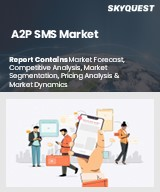
|
시장보고서
상품코드
1819971
프리미엄 메시징 시장 보고서 : 유형, 툴, 최종사용자, 지역별(2025-2033년)Premium Messaging Market Report by Type, Tools, End User, and Region 2025-2033 |
||||||
세계 프리미엄 메시징 시장 규모는 2024년 806억 달러에 달했습니다. IMARC Group은 이 시장이 2033년까지 1,202억 달러에 달하고, 2025-2033년 연평균 성장률(CAGR)은 4.31%를 보일 것으로 전망하고 있습니다.
프리미엄 메시징이란, SMS(Short Message Service)를 자체 숏코드로 전송하는 서비스를 말합니다. SMS 구독에는 표준 메시징 요금 외에 추가 요금이 필요하며, 이 요금은 사용자의 휴대폰 크레딧에 청구됩니다. 이 서비스에서는 단축번호를 통해 길찾기, 퀴즈, 음악, 번역, 벨소리, 전화번호, 검색 결과, 콘테스트 게임, 채팅, 배경화면, 주가 등 다양한 정보와 서비스를 이용할 수 있습니다. 현재 이러한 서비스는 비행기 지연, 스포츠 경기 결과 등 주문형으로 정해진 빈도로 운영되고 있습니다.
프리미엄 메시징 시장 동향 :
모바일 가입자 수의 대폭적인 증가와 이중 인증의 급격한 채택은 시장에 긍정적인 영향을 미치는 주요 요인 중 하나입니다. 또한, 기업들은 현장 서비스 소프트웨어나 고객관계관리(CRM) 등의 용도에 상황별 커뮤니케이션을 통합한 클라우드 애플리케이션 프로그래밍 인터페이스(API)를 활용하고 있습니다. 이를 통해 사용자 등록, 고객과의 상호작용 강화, 보류 중인 서비스에 대한 상태 업데이트 전송을 전 세계적으로 지원하고 있습니다. 또한, 프리미엄 메시징은 자선 및 투표 활동에도 사용할 수 있습니다. 예를 들어, 가입자는 쉽게 SMS 메시지를 보내고, 자연재해 발생 시 기금을 기부하고, 어려운 사람들을 도울 수 있습니다. 또한, 일기예보, 교통정보, 역송전 등의 장점도 있습니다. 이와는 별개로, 병세가 악화됨에 따라 헬스케어 업계에서는 향후 예약에 대한 자동 알림과 번거로움 없는 커뮤니케이션을 위해 프리미엄 메시징의 활용이 확대되고 있습니다. 또한, 전 세계 은행, 금융 서비스 및 보험(BFSI) 부문에서는 직원과의 내부 및 외부 커뮤니케이션을 강화하고, 백엔드 IT 프로세스를 자동화하며, 고객과의 관계 및 서비스를 개선하기 위해 채택하고 있습니다.
본 보고서에서 다룬 주요 질문
- 프리미엄 메시징 세계 시장 규모는?
- 2025-2033년 세계 프리미엄 메시징 시장 성장률 전망은?
- 세계 프리미엄 메시징 시장을 주도하는 주요 요인은?
- 코로나19가 세계 프리미엄 메시징 시장에 미치는 영향은?
- 세계 프리미엄 메시징 시장의 유형별 분류는?
- 세계 프리미엄 메시징 시장에서의 도구별 구분은?
- 세계 프리미엄 메시징 시장의 최종 사용자별 구분은?
- 세계 프리미엄 메시징 시장의 주요 지역은?
- 세계 프리미엄 메시징 시장의 주요 기업은?
목차
제1장 서문
제2장 조사 범위와 조사 방법
- 조사 목적
- 이해관계자
- 데이터 소스
- 1차 정보
- 2차 정보
- 시장 추정
- 보텀업 접근
- 톱다운 접근
- 조사 방법
제3장 주요 요약
제4장 서론
제5장 세계의 프리미엄 메시징 시장
- 시장 개요
- 시장 실적
- COVID-19의 영향
- 시장 예측
제6장 시장 분석 : 유형별
- A2P 메시징
- P2A 메시징
제7장 시장 분석 : 툴별
- 클라우드 API 메시징 플랫폼
- 기존 및 매니지드 메시징 서비스
제8장 시장 분석 : 최종사용자별
- 은행, 금융서비스 및 보험(BFSI)
- 교통 및 여행
- 헬스케어
- 미디어 및 엔터테인먼트
- 소매업 및 E-Commerce
- IT 및 통신
- 정부
- 기타
제9장 시장 분석 : 지역별
- 북미
- 미국
- 캐나다
- 아시아태평양
- 중국
- 일본
- 인도
- 한국
- 호주
- 인도네시아
- 기타
- 유럽
- 독일
- 프랑스
- 영국
- 이탈리아
- 스페인
- 러시아
- 기타
- 라틴아메리카
- 브라질
- 멕시코
- 기타
- 중동 및 아프리카
제10장 SWOT 분석
제11장 밸류체인 분석
제12장 Porter의 Five Forces 분석
제13장 가격 분석
제14장 경쟁 구도
- 시장 구조
- 주요 기업
- 주요 기업 개요
- AMD Telecom S.A.
- AT&T Inc.
- Comviva Technologies Limited(Tech Mahindra Limted)
- Infobip Ltd.
- Mavenir
- Sinch
- Syniverse Technologies LLC
- Tata Communications Limited
- Twilio Inc.
- Tyntec
- Verizon Communications Inc.
The global premium messaging market size reached USD 80.6 Billion in 2024. Looking forward, IMARC Group expects the market to reach USD 120.2 Billion by 2033, exhibiting a growth rate (CAGR) of 4.31% during 2025-2033.
Premium messaging refers to a service wherein Short Message Service (SMS) is sent using a unique short code. Its subscription requires an additional fee compared to the standard messaging rate, which is billed into the user's mobile credits. It gives access to various information and services, including routes, quizzes, music, translations, ringtones, phone numbers, search results, contest games, chat sessions, background images, and stock exchange prices, using speed dial numbers. Nowadays, these services operate on-demand and at a predetermined frequency, such as flight delays and sports results.
Premium Messaging Market Trends:
A significant increase in the number of mobile subscribers, along with the surging adoption of two-factor authentication, represents one of the key factors positively influencing the market. Moreover, enterprises are utilizing cloud application programming interface (API) with embedded contextual communications for applications, such as field service software and customer relationship management (CRM). This is aiding in registering users, enhancing customer interaction, and sending status updates on pending services globally. In addition, premium messaging can be used for charity and voting activities. For instance, subscribers can easily send an SMS message to donate funds and help people in need during a natural disaster. It also provides the benefits of weather alerts, transport updates, and reverse charge phone calls. Apart from this, the rising prevalence of medical conditions is expanding the use of premium messaging in the healthcare industry for automatic reminders about upcoming appointments and hassle-free communication. Furthermore, it is employed in the banking, financial services, and insurance (BFSI) sector across the globe to enhance internal and external communications with staff, automate back-end IT processes, and improve customer relations and services.
Key Market Segmentation:
Breakup by Type:
- A2P Messaging
- P2A Messaging
Breakup by Tools:
- Cloud API Messaging Platform
- Traditional and Managed Messaging Services
Breakup by End User:
- BFSI
- Transport and Travelling
- Healthcare
- Media and Entertainment
- Retail and E-Commerce
- IT and Telecom
- Government
- Others
Breakup by Region:
- North America
- United States
- Canada
- Asia-Pacific
- China
- Japan
- India
- South Korea
- Australia
- Indonesia
- Others
- Europe
- Germany
- France
- United Kingdom
- Italy
- Spain
- Russia
- Others
- Latin America
- Brazil
- Mexico
- Others
- Middle East and Africa
Competitive Landscape:
The competitive landscape of the industry has also been examined along with the profiles of the key players being AMD Telecom S.A., AT&T Inc., Comviva Technologies Limited (Tech Mahindra Limted), Infobip Ltd., Mavenir, Sinch, Syniverse Technologies LLC, Tata Communications Limited, Twilio Inc., Tyntec and Verizon Communications Inc.
Key Questions Answered in This Report
- 1.How big is the global premium messaging market?
- 2.What is the expected growth rate of the global premium messaging market during 2025-2033?
- 3.What are the key factors driving the global premium messaging market?
- 4.What has been the impact of COVID-19 on the global premium messaging market?
- 5.What is the breakup of the global premium messaging market based on the type?
- 6.What is the breakup of the global premium messaging market based on the tools?
- 7.What is the breakup of the global premium messaging market based on the end user?
- 8.What are the key regions in the global premium messaging market?
- 9.Who are the key players/companies in the global premium messaging market?
Table of Contents
1 Preface
2 Scope and Methodology
- 2.1 Objectives of the Study
- 2.2 Stakeholders
- 2.3 Data Sources
- 2.3.1 Primary Sources
- 2.3.2 Secondary Sources
- 2.4 Market Estimation
- 2.4.1 Bottom-Up Approach
- 2.4.2 Top-Down Approach
- 2.5 Forecasting Methodology
3 Executive Summary
4 Introduction
- 4.1 Overview
- 4.2 Key Industry Trends
5 Global Premium Messaging Market
- 5.1 Market Overview
- 5.2 Market Performance
- 5.3 Impact of COVID-19
- 5.4 Market Forecast
6 Market Breakup by Type
- 6.1 A2P Messaging
- 6.1.1 Market Trends
- 6.1.2 Market Forecast
- 6.2 P2A Messaging
- 6.2.1 Market Trends
- 6.2.2 Market Forecast
7 Market Breakup by Tools
- 7.1 Cloud API Messaging Platform
- 7.1.1 Market Trends
- 7.1.2 Market Forecast
- 7.2 Traditional and Managed Messaging Services
- 7.2.1 Market Trends
- 7.2.2 Market Forecast
8 Market Breakup by End User
- 8.1 BFSI
- 8.1.1 Market Trends
- 8.1.2 Market Forecast
- 8.2 Transport and Travelling
- 8.2.1 Market Trends
- 8.2.2 Market Forecast
- 8.3 Healthcare
- 8.3.1 Market Trends
- 8.3.2 Market Forecast
- 8.4 Media and Entertainment
- 8.4.1 Market Trends
- 8.4.2 Market Forecast
- 8.5 Retail and E-Commerce
- 8.5.1 Market Trends
- 8.5.2 Market Forecast
- 8.6 IT and Telecom
- 8.6.1 Market Trends
- 8.6.2 Market Forecast
- 8.7 Government
- 8.7.1 Market Trends
- 8.7.2 Market Forecast
- 8.8 Others
- 8.8.1 Market Trends
- 8.8.2 Market Forecast
9 Market Breakup by Region
- 9.1 North America
- 9.1.1 United States
- 9.1.1.1 Market Trends
- 9.1.1.2 Market Forecast
- 9.1.2 Canada
- 9.1.2.1 Market Trends
- 9.1.2.2 Market Forecast
- 9.1.1 United States
- 9.2 Asia-Pacific
- 9.2.1 China
- 9.2.1.1 Market Trends
- 9.2.1.2 Market Forecast
- 9.2.2 Japan
- 9.2.2.1 Market Trends
- 9.2.2.2 Market Forecast
- 9.2.3 India
- 9.2.3.1 Market Trends
- 9.2.3.2 Market Forecast
- 9.2.4 South Korea
- 9.2.4.1 Market Trends
- 9.2.4.2 Market Forecast
- 9.2.5 Australia
- 9.2.5.1 Market Trends
- 9.2.5.2 Market Forecast
- 9.2.6 Indonesia
- 9.2.6.1 Market Trends
- 9.2.6.2 Market Forecast
- 9.2.7 Others
- 9.2.7.1 Market Trends
- 9.2.7.2 Market Forecast
- 9.2.1 China
- 9.3 Europe
- 9.3.1 Germany
- 9.3.1.1 Market Trends
- 9.3.1.2 Market Forecast
- 9.3.2 France
- 9.3.2.1 Market Trends
- 9.3.2.2 Market Forecast
- 9.3.3 United Kingdom
- 9.3.3.1 Market Trends
- 9.3.3.2 Market Forecast
- 9.3.4 Italy
- 9.3.4.1 Market Trends
- 9.3.4.2 Market Forecast
- 9.3.5 Spain
- 9.3.5.1 Market Trends
- 9.3.5.2 Market Forecast
- 9.3.6 Russia
- 9.3.6.1 Market Trends
- 9.3.6.2 Market Forecast
- 9.3.7 Others
- 9.3.7.1 Market Trends
- 9.3.7.2 Market Forecast
- 9.3.1 Germany
- 9.4 Latin America
- 9.4.1 Brazil
- 9.4.1.1 Market Trends
- 9.4.1.2 Market Forecast
- 9.4.2 Mexico
- 9.4.2.1 Market Trends
- 9.4.2.2 Market Forecast
- 9.4.3 Others
- 9.4.3.1 Market Trends
- 9.4.3.2 Market Forecast
- 9.4.1 Brazil
- 9.5 Middle East and Africa
- 9.5.1 Market Trends
- 9.5.2 Market Breakup by Country
- 9.5.3 Market Forecast
10 SWOT Analysis
- 10.1 Overview
- 10.2 Strengths
- 10.3 Weaknesses
- 10.4 Opportunities
- 10.5 Threats
11 Value Chain Analysis
12 Porters Five Forces Analysis
- 12.1 Overview
- 12.2 Bargaining Power of Buyers
- 12.3 Bargaining Power of Suppliers
- 12.4 Degree of Competition
- 12.5 Threat of New Entrants
- 12.6 Threat of Substitutes
13 Price Analysis
14 Competitive Landscape
- 14.1 Market Structure
- 14.2 Key Players
- 14.3 Profiles of Key Players
- 14.3.1 AMD Telecom S.A.
- 14.3.1.1 Company Overview
- 14.3.1.2 Product Portfolio
- 14.3.2 AT&T Inc.
- 14.3.2.1 Company Overview
- 14.3.2.2 Product Portfolio
- 14.3.2.3 Financials
- 14.3.2.4 SWOT Analysis
- 14.3.3 Comviva Technologies Limited (Tech Mahindra Limted)
- 14.3.3.1 Company Overview
- 14.3.3.2 Product Portfolio
- 14.3.4 Infobip Ltd.
- 14.3.4.1 Company Overview
- 14.3.4.2 Product Portfolio
- 14.3.5 Mavenir
- 14.3.5.1 Company Overview
- 14.3.5.2 Product Portfolio
- 14.3.6 Sinch
- 14.3.6.1 Company Overview
- 14.3.6.2 Product Portfolio
- 14.3.6.3 Financials
- 14.3.7 Syniverse Technologies LLC
- 14.3.7.1 Company Overview
- 14.3.7.2 Product Portfolio
- 14.3.8 Tata Communications Limited
- 14.3.8.1 Company Overview
- 14.3.8.2 Product Portfolio
- 14.3.8.3 Financials
- 14.3.8.4 SWOT Analysis
- 14.3.9 Twilio Inc.
- 14.3.9.1 Company Overview
- 14.3.9.2 Product Portfolio
- 14.3.9.3 Financials
- 14.3.9.4 SWOT Analysis
- 14.3.10 Tyntec
- 14.3.10.1 Company Overview
- 14.3.10.2 Product Portfolio
- 14.3.11 Verizon Communications Inc.
- 14.3.11.1 Company Overview
- 14.3.11.2 Product Portfolio
- 14.3.11.3 Financials
- 14.3.11.4 SWOT Analysis
- 14.3.1 AMD Telecom S.A.



















